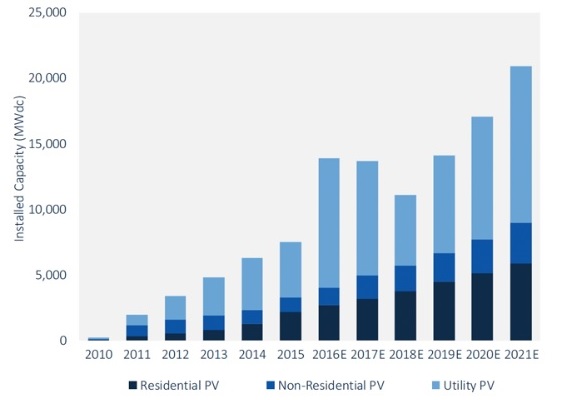Operators urged to use aerial scans, data modeling to cut residential O&M costs
Operators in the growing U.S. residential solar market must use the latest infrared scanning and plant modeling technology to reduce truck rolls and increase the return on maintenance activities, Mike Moone, Director, Energy Assurance at SunPower, said.

Related Articles
U.S. growth in residential solar installations is set to continue in the coming years and operations and maintenance [O&M] providers must provide innovative solutions to help lower the levelized cost of energy and ensure a sustainable solar industry.
Residential O&M providers must focus on challenges for distributed generation projects which often differ from those for utility-scale plants, Moone told the PV Operations & Maintenance USA conference on December 7.
Residential market operators can achieve significant cost savings by reducing the number of truck rolls and prioritizing corrective maintenance by magnitude of energy shortfall, he said.
"The goal isn't necessarily as much around failure prevention but actually around limiting the amount of truck rolls that you have to incur...truck rolls are very expensive on smaller system sizes," Moone said.
O&M providers must also reduce the risk of systemic underperformance for residential projects and, where possible, synergize resources in place for large-scale plant services, he added.
US residential solar costs

Source: National Renewable Energy Laboratory (September 2016)
SunPower has been in the U.S. solar market for over 30 years and has been able to leverage expertise across its residential, commercial and utility-scale solar businesses.
The Californian company operates and manages around 45,000 individual systems under active O&M contracts, including a capacity of around 2.2 GW of systems under 1 MW.
In 2011, SunPower launched a residential lease program and this led to much greater focus on residential O&M efficiencies, Moone said.
"The good thing was we had a lot of learnings to draw from on the commercial and utility side," he said.
Aerial assessments
Operators must leverage the latest technology and data services to limit the number of site visit 'truck rolls' and control the costs of servicing a residential portfolio, Moone said.
Truck roll costs are estimated at around $50 per kWp for a 5 kW residential project, compared with just 2 cents/kWp for a 50 MW utility-scale project and $1/kWp for a 500 kW commercial site, he said.
Assuming solar LCOE cost savings of 10% over other forms of generation, the cost of truck roll as a percentage of customer savings rises from 0.1% for a 50 MW utility-scale plant to 195% for a 5 kW residential site, Moone said.
"So a single truck roll can eat through twice the entire savings in the value proposition of that project," he said.
One way of curbing truck roll cost is by using Aerial Infrared (IR) scanning to assess multiple distributed generation sites.
Aerial IR scanning can assess 30 sites per day and is particularly effective for sites using string inverters due to their minimal preventative maintenance requirements, Moone said.
"If you have a site with string inverters and you don't have any other equipment that requires an annual manual preventative maintenance visit, you could theoretically replace the entire preventative maintenance visit for that site with an IR scan," he said.
In addition, satellite weather data can be used to monitor the performance of residential portfolios, avoiding upfront costs of around $5,000 associated with MET stations, Moone noted.
While satellite weather data is not as accurate as MET station data, the accuracy is within reasonable tolerances for residential projects and does not require the recalibration of weather stations which incurs further truck roll costs, he said.
Detailed monitoring
Residential O&M providers must prioritize corrective maintenance based on energy shortfalls and track individual site soiling conditions to develop a strategic cleaning plan.
Utility-scale projects can benefit from standardized and scalable cleaning techniques-- such as the use of robotics-- but for distributed projects every site will soil a little differently.
"Factors such as local variables, the tilt, the azimuth, the frames of the module-- they all influence the rates that they soil," Moone said.
SunPower runs PV plant simulator software throughout the O&M phase of residential projects to monitor performance, he said.
The PVSim modeller takes ambient weather conditions irradiance, temperature and wind speed and factors in site-specific technologies to produce a performance prediction.
The software tool allows the company to make "an apples to apples comparison" of every site relative to its original model and can be deployed across a large number of sites, Moone said.
"Anyone who is looking to enter into the distributed generation market has to be prepared to manage that horizontal scale-- scale across sites rather than scale within sites," he said.
Operators should also look to optimize their current workforce across multiple market segments, Moone said.
SunPower's Remote Operations Control Center (ROCC) was originally designed to manage utility-site operations but the company found the center could also help optimise scheduling programs for distributed generation sites, such as cleaning plans.
"We can run processes like that out of centralised locations with the right tools and the right investment in purpose-driven software," he said.
US solar installation forecast by market segment

Source: GTM Research, SEIA (December 2016)
Inheritance checks
A key issue for residential portfolios is systemic underperformance, for example due to site shading exceeding expectations.
O&M providers must avoid inheriting systemic underperformance from the offset, Moone said.
"There are a lot of tools being developed in the industry that allow you to better measure [shading] and account for that upfront," he said.
O&M providers should implement design reviews to ensure proposed designs match the simulation inputs and performance tests should be performed when operational, Moone said.
"If you can keep a hook in the installer's contract where you don't pay them an amount until it passes that test, that is a very effective way to align incentives and ensure that when systems are taken over from the O&M side they are starting from a good performance perspective," he said.
Guaranteed savings
O&M providers must also be prepared to deliver guarantees on energy delivery and savings required by residential customers, Moone noted.
Residential customers have less use for plant availability-based guarantees used for larger plants, as they prioritize energy production and gaining savings for their upfront payments, he said.
In addition, billing structures are changing as many utilities are looking to introduce demand charges in the residential market, imposed on customers’ highest usage points over a certain billing period. This move is in response to a long-term decline in U.S. energy demand and changing residential usage patterns due to new technologies such as energy storage and smart grid technologies.
In this context, some residential solar customers are now seeking guarantees against the actual savings achieved from their solar plants during the operations phase, Moone said.
"We are seeing that now-- especially as storage is coming into play-- with things like demand charge reduction guarantees," he said.
New Energy Update
